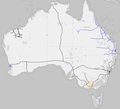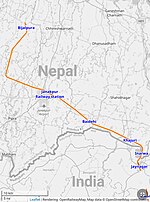operates on 1,676 mm (5 ft 6 in) broad gauge. Most of the metre gauge and narrow gauge railways have been converted to broad gauge. Small stretches of the...
16 KB (1,654 words) - 14:15, 14 November 2024
Railways with a track gauge of 3 ft 6 in (1,067 mm) were first constructed as horse-drawn wagonways. The first intercity passenger railway to use 3 ft...
25 KB (1,612 words) - 23:03, 5 November 2024
2 ft 6 in (762 mm) gauge railways are narrow gauge railways with track gauge of 2 ft 6 in (762 mm). This type of rail was promoted especially in the colonies...
6 KB (143 words) - 10:00, 9 November 2024
Railways with a track gauge of 5 ft 3 in (1,600 mm) fall within the category of broad gauge railways. As of 2022[update], they were extant in Australia...
10 KB (740 words) - 01:59, 28 October 2024
The 4 ft 6 in (1,372 mm) track gauge, also called the Scotch gauge, was adopted by early 19th century railways mainly in the Lanarkshire area of Scotland...
12 KB (1,213 words) - 23:31, 6 August 2024
Railways with a railway track gauge of 5 ft (1,524 mm) first appeared in the United Kingdom and the United States. This gauge became commonly known as...
28 KB (2,658 words) - 05:48, 28 October 2024
Three foot gauge railways have a track gauge of 3 ft (914 mm) or 1 yard. This gauge is a narrow gauge and is generally found throughout North, Central...
9 KB (249 words) - 13:19, 13 July 2024
A list of 2 ft 6 in gauge railways in Japan. Anbō Forest Railway [jp] (operational status unknown) DisneySea Electric Railway (located in Tokyo DisneySea)...
3 KB (340 words) - 20:39, 20 July 2024
and 600 mm gauge railways are narrow gauge railways with track gauges of 2 ft (610 mm) and 600 mm (1 ft 11+5⁄8 in), respectively. Railways with similar...
25 KB (663 words) - 20:54, 8 November 2024
broad-gauge railway is a railway with a track gauge (the distance between the rails) broader than the 1,435 mm (4 ft 8+1⁄2 in) used by standard-gauge railways...
32 KB (4,247 words) - 03:21, 8 October 2024
Iberian gauge (Spanish: ancho ibérico, trocha ibérica, Portuguese: bitola ibérica) is a track gauge of 1,668 mm (5 ft 5+21⁄32 in), most extensively used...
8 KB (858 words) - 10:57, 6 November 2024
narrow-gauge railway (narrow-gauge railroad in the US) is a railway with a track gauge narrower than 1,435 mm (4 ft 8+1⁄2 in) standard gauge. Most narrow-gauge...
22 KB (2,496 words) - 09:21, 9 November 2024
500 mm (19+3⁄4 in) and 4 ft 8+1⁄2 in (1,435 mm) standard gauge. Trains portal List of tram track gauges Loading gauge Minimum-gauge railway Rail transport...
68 KB (1,924 words) - 04:10, 23 November 2024
Metre-gauge railways (US: meter-gauge railways) are narrow-gauge railways with track gauge of 1,000 mm (3 ft 3+3⁄8 in) or 1 metre. Metre gauge is used in around...
20 KB (223 words) - 11:29, 29 September 2024
A standard-gauge railway is a railway with a track gauge of 1,435 mm (4 ft 8+1⁄2 in). The standard gauge is also called Stephenson gauge (after George...
55 KB (3,620 words) - 22:45, 4 November 2024
1838 with a gauge of 5 ft 6 in (1,676 mm), and the Ulster Railway of 1839 used 6 ft 2 in (1,880 mm). Locomotives were being developed in the first decades...
54 KB (5,379 words) - 03:17, 9 September 2024
A loading gauge is a diagram or physical structure that defines the maximum height and width dimensions in railway vehicles and their loads. Their purpose...
78 KB (8,690 words) - 08:41, 1 October 2024
In railway engineering, "gauge" is the transverse distance between the inner surfaces of the heads of two rails, which for the vast majority of railway...
56 KB (5,442 words) - 14:38, 18 October 2024
three main railway gauges in Australia are narrow: 1,067 mm (3 ft 6 in), standard: 1,435 mm (4 ft 8+1⁄2 in), and broad: 1,600 mm (5 ft 3 in). A slow progression...
43 KB (4,390 words) - 17:29, 4 November 2024
With railways, a break of gauge occurs where a line of one track gauge (the distance between the rails, or between the wheels of trains designed to run...
47 KB (5,499 words) - 12:48, 7 October 2024
2 ft 6 in (762 mm) freight railway in 1937, and subsequently became a passenger railway. It closed in 2014 to allow it to be converted to 5 ft 6 in (1...
24 KB (2,260 words) - 19:00, 1 November 2024
gauges were used in the United States. Some railways, primarily in the northeast, used standard gauge of 4 ft 8+1⁄2 in (1,435 mm); others used gauges...
21 KB (2,608 words) - 20:02, 23 September 2024
Bosnian-gauge railways are railways with track gauge of 760 mm (2 ft 5+15⁄16 in). These were found extensively in the former Austro-Hungarian Empire as...
9 KB (553 words) - 20:51, 3 November 2024
track gauges: 18,007 kilometres (11,189 mi) of standard gauge (1435 mm / 4 ft 81⁄2 in), 2,685 kilometres (1,668 mi) of broad gauge (1600 mm / 5 ft 3 in),...
52 KB (5,300 words) - 22:10, 22 November 2024
industrial railways. Prominent examples include: the 3 ft 6 in (1,067 mm) gauge Little Eaton Gangway of 1793; the 3 ft 4+3⁄4 in (1,035 mm) gauge Lake Lock...
72 KB (2,549 words) - 15:30, 5 November 2024
4 ft 8 in gauge railways are railways with a track gauge of 4 ft 8 in / 1,422 mm. This gauge is 1⁄2 inch (13 mm) less than 4 ft 8+1⁄2 in (1,435 mm) standard...
5 KB (455 words) - 01:15, 12 September 2022
524 mm (5 ft) gauge, both known as Russian gauge; the railways in India, Pakistan, Bangladesh and Sri Lanka use the 1,676 mm (5 ft 6 in) gauge, known as...
20 KB (2,180 words) - 14:29, 7 September 2024
Llanfair Light Railway (W&LLR) (Welsh: Rheilffordd y Trallwng a Llanfair Caereinion) is a 2 ft 6 in (762 mm) narrow gauge heritage railway in Powys, Wales...
25 KB (1,462 words) - 06:01, 9 November 2024
locomotives from Henschel of Kassel in Germany, which were put to work on a 2 ft 6 in (762 mm) gauge roadside railway, 7 kilometres (4.3 mi) long, linking...
38 KB (4,088 words) - 06:10, 23 November 2024
railways in Europe use the standard gauge of 1,435 mm (4 ft 8+1⁄2 in). Some countries use broad gauge, of which there are three types. Narrow gauges are...
1 KB (154 words) - 11:03, 21 July 2024








